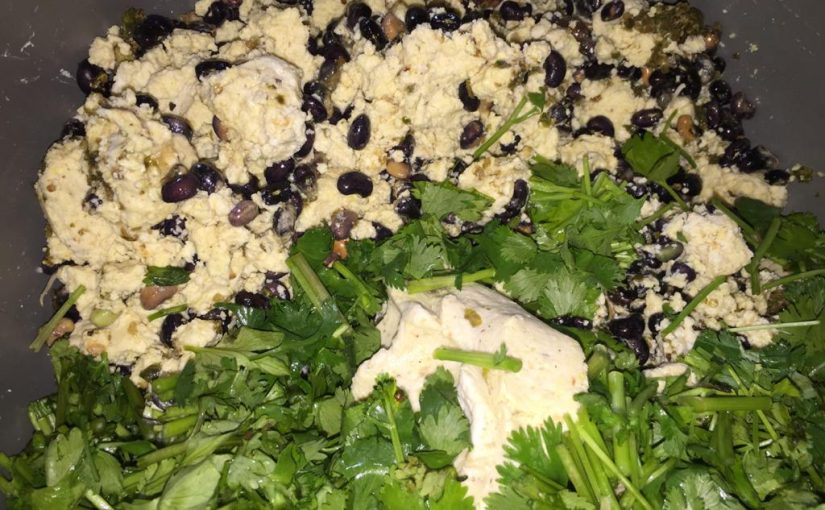In this lesson we will learn about cornfields, beans and food among the Huasteca Nahua.
The cornfield is a complex ecosystem where the Nahua plant a lot of things in addition to corn using traditional agricultural methods. In general, agricultural labor is done using traditional tools.
People in Chicontepec typically eat three square meals a day. In the morning, in addition to coffee and bread, a stew is prepared and eaten with tortillas sometime between 7 and 8 AM. At 11 AM, people cook fresh tortillas for lunch. After 5 PM, the same process is repeated to have dinner ready between 6 and 7 PM. We will learn about dishes prepared with beans in this region of Veracruz.
Note: Images used in this lesson were created by the following people:
CC BY Sabina y Catalina Cruz
CC BY-SA Peotrovitch
CC BY-SA Simon A. Eugester
CC BY Josefrayn
In the following section, we will see the names and tools that are used to cultivate the cornfields.
Tlen motequihuia pan mīllah (What is used in the cornfield)
/macheteh/ “machete”
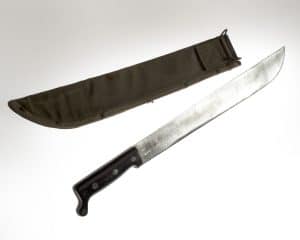
Ni cē tlamantli tepōztli tlen quitequihuiah pan mīllah huan pan calli, ica quitequizceh ce tlamantli, tlaixhuitequizceh, quitequizceh xīhuitl tlen axcualli huan ayoccanah ma mozcalti.
“This tool is used in the cornfield and at home in order to cut and cut the weeds that might damage the cornfields.”
/azadon/ “tilling hoe”

Ni cē tlamantli tepōztli tlen quitequihuiah ica quimācuizceh xīhuitl ica itzonyo, xīhuitl tlen eltoqueh tlatlahco tlen piltoctzitzin, quimācuih para ma mozcalticān cualli huan yehyēctzitzin.
“This tool is used in order to take out the weeds from their root, which are among the stems of the corn plants. This is done in order to clean the area and that stems can grow good and healthy.”
/huincaroh/ “billhook”
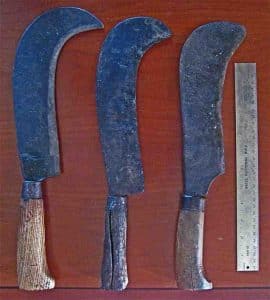
Ni cē tlamantli tepōztli quēntzin tlacuelolli iyācapan huan quitequihuiah ica quitequizceh xīhuitl tlen eltoc inacaztlan piltoctzitzin o cequin tlamantli tlacualiztli, ni quitequih pampa ax quicāhua ma mozcaltih tlamantli tlen mocuā.
“This tool is a cutting blade with a hooked tip and it is used to cut weeds that are next the stems of corn plants or other produce, which might damage their growth.”
/alimah/ “filer”
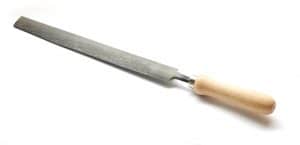
Ni cē tepōztli tlen quitequihuiah ica quitēntizceh macheteh o ceyoc tlamantli tlen hueliz tlatequiz.
“The file is used to sharpen machetes or other tools for cutting.”
/pixcōmitl/ “tool to shucking ears of corn”
Ni cē piltepōztzin tlen quitequihuiah ica quixīpehuazceh cīntli tlen petlayoh, ni quēn cē acoxah zan achi quēntzin huēyi hueliz caxtōlli centímetros.
“This tool is used to peel the husks of corn, which is like a large needle, approximately 15 centimeters in length.”
/cuachiquihuitl/ “large basket”
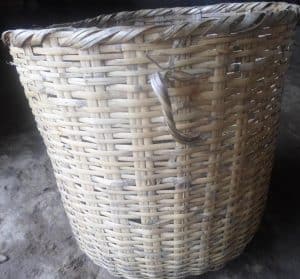
Ni cē chiquihuitl huēyi huan huahcapantic hueliz tlahco metro. Ni motequihuia quēmman pixcah, quimāmāh huan iihtico quitēmah cīntli tlen quiquixtihtiyohuih pan tōccuahuitl.
“This is a large basket, approximately a half a meter in height. This tool is used in order to deposit harvested corn and placed on the back of someone.”
/cuatlatōctli/ “point to deposit seeds of corn and beans”
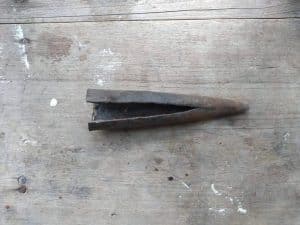
Ni cē cuahuitl tlatentilli tlen īcā tlacoyoniah quēmman tōcah huan quitōcah etl. Ni īhuexca hueliz cē metro huan tlahco.
“This is a pointed edge that is used in order to make wholes on the field so that corn and bean seeds can be deposited. This is approximately a meter and a half in length.”
Tlatōquiliztli tlen cīntli (The planting of corn)
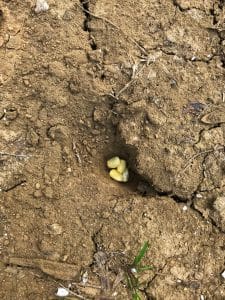
Tlamantli tlatōquiliztli tlahuel yehyēctzin pampa ni tōnatiuh chãnehqueh tlācatl huan cihuātl motequihuiah. Quēmman tōcah monequi quincafenmācazceh huan quintlamācazceh tlen quipalehuizceh tōcah. Tlācatl mēhua niman pēhua quinemilia īpilxināch, quitēma pan cē coxtalli pampa quēuhquinon quihuīcaz cāmpa quitōcaz (mīllah). Tlen tēpalehuizceh monequih panozceh yāhuatzinco īchān tlācatl tlen tocāz huan teipan yāzceh mīllah. Yeca cihuātl monemilia īcā cafen huan tlacualiztli tlen yāhuatzinco pampa monequi quintlamācaz pan chicōme cāhuitl. Noque ahcih tequitinih tētah pēhua quicui tlen quihuīcaz mīllah quen; īmorral, īāuh huan zemprador. Tequitinih ahcih pan chicōme cāhuitl, tlācatl quinmāca ātl ma momahtequicān, tlacuāh nochi zancehco huan quēmman tlamihya tlacuāh mochiyah cē tlatōctzin teipan yohuihya nochi zancehco mīllah cāmpa tōcazceh.
Ahcih millāh zancualliya pan chicuēyi cāhuitl, huanquinon cehcen monemilia īcā īpuntal huan tlen chāneh quinmahmāca pilxināchtzin pan ininmorral tlen quitōcazceh. Tlācatl tlen quipalehuiah ya tlayecāna quēmman tōcah. Quēmman tōcah niman tlamih huan axcanah tequitih cemilhuitl, huan mocuapah cāmpa tlen chāneh īchān huan ya quinmāca cē ōme litroh huinoh, tzopēlātl huan quintlamāca quēn nopa tlami inintōnatiuh quiōnih cē quēntzin chichic.
Next we will see the names of various dishes that use beans and are cooked in Chicontepec, Veracruz.
Tlahcuiloliztli tlen tlacualli (Writings about food)
/tici/ “to cook”
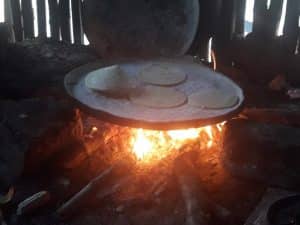
Cē cihuātl īcā yāhuatzinco ya mēhua achtohui, yohui cāmpa tlacualchīhua, nopayoh tlipītza, noque cāhuani tlitl, ya pēhua quipahpāca īpilchachapal tlen pan quimānaz īcafen. Teipan noque molōni cafen quipāca nextamalli huan teipan pēhua tlaxamānia pan molinoh zo pan metlatl.
Quēmman molōnquiya cafen, quicafenmāca ītētah huan ininconēhuan, tlan itztoqueh conēmeh pampa yāzceh momachtitih. Nicān cihuātl axcanah mocēhuia tlan quiōniz cafen pampa ya monequi quicencuiliz ītequiuh. Quēmman tlami tlaxamānia, ya quiātilia itix huan teipan quitlipichia īcomal, nouhquiya quicualtlālia tlen quicuāzceh yāhuatzinco. Cihuātl tlatehtēca huan quintlamāca nochimeh, teipan ya tlacuā īcelti quēmman nochi yāhquehya cāmpa tequitih zo momachtiah. Ya mocāhua calihtic īcelti motequichīhua.
/etlatzoyontli/ “refried beans”
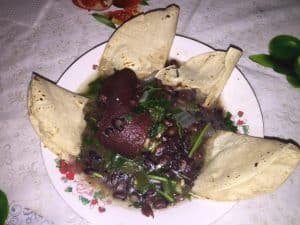
Cē tlacualiztli tlen mochīhua īcā etl, iztātl, ātl, aceyiteh, chīlli, cebollah huan colantoh. Ni axoncah tōnatiuh para mocuāz, mocuā zan quēmman quinequizceh. Ni tlacualiztli tlahuel ahhuīac, quēn achtohui momolōnia etl īcā ātl huan achi iztātl. Noque molōni quitehtequih chīlli, cebollah huan colantoh. Quēmman iuccicca etl motepēxōhuia huan momāna cē cuecuetztzin pilchachapaltzin cāmpa motzoyōniz cē quēntztin etl. Quēmman momantōcca pilchachapaltzin pan tlitl huan totōnicca huahca motēquilia achi aceyiteh teipan motēmilia cebollah huan chīlli, iucci cualli teipan motēquilia ōme zo ēyi polatoh etl tlen momolōnihqui pan huēyi chachapalli huan quēnnopa mocāhua ma molōni cualli.
Teipan motepēxihuia huan cāmpa motlicomāna chachapalli tlen quipiya miac etl. Quēmman molōniya huāccā motēquilia nopa etl tlen motzoyōnihqui pan pilchachapaltzin. Quēnnopa mocāhua nochi zancehco ma molōni huan teipan motepēxihuia.
Answer the following questions about the previous dishes:
- Tlen quichīhua cihuātl īcā yohuatzinco?
- Quēnque axcanah cafeōni cihuātl?
- Īcā tlen tlacualiztli zaniloa tlahcuiloliztli?
- Tlen quitlalhuiliah tlacualiztli?
- Quēnque momāna ceyoc pilchachapaltzin
/piquiz/ “bean tamales”
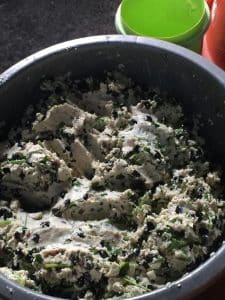
Cē tlacuāliztli tlen mochīhua pan pilaltepētzitzin tlen Chicōntēpec. Ni cē tlacuālliztli tlen mochihchīhua zan īcā tixtli, etl, iztātl huan chiīli tlamoltili, mantecah zo aceyiteh huan nouhquiya totomochtli. Ni totomochtli moāquechia tlen pan quipiquizceh tixtli. Axoncah cē tōnatiuh quēmman mocualtlālia zan quēmman quinequih quicuāzceh huāccā quichihchīhuah.
Tlen achtohui mochīhua momolōnia etl īcā quēntzin iztātl, noque molōni moxamānia nextamalli. Quēmman eltocca etl huan quēntzin ceuhquiya huāccā cihuātl quicui tixhuapalli zo cē tecōmitl huēyi, nopayoh quitēma tixtli huan pēhua quitēmilia etl, iztātl, chīlli huan mantecah teipan pēhua quimaneloā nochi zancehco, quimachilia tlan cualtitocca īcā iztātl huan chīlli. Teipan pēhuaya quicui achi quēnce cē pilmahtzoltzin huan quitlālia pan totomochtli quichīhua piltolontzin huan quipiqui cualli.
Quēmman tlamiya quichīhua nochi, quimāna cē chachapalli huēyi pan tlitl īcā quēntzin ātl, quipehpechtia ica ōlōtl, nopayoh quitēma nochi nopa piquiz huan cualli quitlipichia para ma iucci. Mocāhua pan tlitl hueliz ōme cāhuitl ma cualli molōni. Teipan quimachilia tlan iuccicca huan tlan eltocca huāccā quitepēxihuia huan tlacuāh.
/etixtli/ “bean corn cakes”
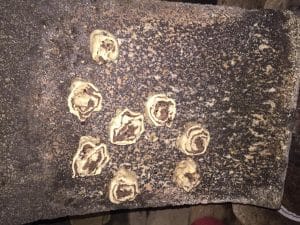
Cē tlamantli tlacualiztli tlen mochihchīhua zan quēmman quinequih quicuāzceh, tiquihtozceh axcanah monequi cē tōnatiuh, quēnce cē ilhuitl. Ni tlacuāliztli mochihchīhua zan īcā etl tlatixtli, iztātl, alahhueno, chīlli huan mantecah. Achtohui momolōnia etl huan moxamānia nextamalli. Nouhquiya mocacatzoa alahhueno pan comalli teipan motici pan metlatl axcanah motēquilia ātl, queuhquinon zan huāctoc. Quēmman iucciya etl pēhua quiticih pan metlatl, quēmman tlamiya quiticih quichīhuah zan tolōntic huan quitlalhuiliah iztātl, alahhuenoh tlatixtli huan achi mantecah, quitlāliah īnacaztlan tixhuapalli.
Teipan quiātiliah tixtli huan pēhuah quipahpatlahuah pan metlatl zan tlen zancualli axmaz tilāhuac. Teipan iīxco quitlalhuiliah etl tlatixtli huan pēhuah quimimiloah nochi huan quicotōntiyohuih zan tlen zancualli para quichīchuaz cē piltilactzin. Quichihchīhuah zan pan ininmāh huan quitēcah pan comalli ma iucci, quicuahcuapah quēnce cē tlaxcallli parah ma cualli iucci.
/etlāpanilli/ “soup of beans with avocado and chilli”
Cē tlacuāliztli nouhquiya axcanah oncah cē tōnatiuh para mocuāz. Nicān motēquihuia etl, tixtli, iztātl, āhuacāizhuatl, huan chīlli. Motēquihuia etl tlen yancuīc, celic, zo maneltic. Achtohui motlapāna teipan mopahpāca huan momolōnia īcā iztātl. Quēmman iuccicca monemilia cē achi tixtli huan moātilia, nouhquiya momoltilia achi chīlli huan momaneloa ica āhuacāizhuatl. Ni etl axcanah motepēhxihuia, ni mochihchīhua tlixihco huan nopayoh quitēmilia nochi tlacuālpahtli tlen monequi para ni tlacuāliztli. Motēmilia tixtli tlaātili, āhuacātl ixihuiyo tlailpili, (cē mācuilli), chīlli zan tlen zancualli huan iztātl. Quēuhquinon mocuahtlālia teipan momachilia tlan cualtitocca quēmman molōnquiya motepexōhuia.
/pātzcalli/ “soup of beans with sesame seeds and chilli”
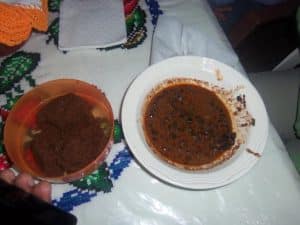
Ni tlacuāliztli mochīhua zan pan ilhuitl tlen itlamiyah tōnatiuh tlen mēztli tlen Octubre. Ni tlacuāliztli quihuīca etl, aholin, chīlli, xōnacatl huan alahhueno. Etl momolōnia īcā ātl huan achi iztātl. Noque iucci etl, nouhquiya mocacātzoa aholin huan teipan motici pan metlatl nopayoh quitlalhuilia achi chīlli huan īcā quiticih zancehco. Ni eli yehyēctzin chīchīltic huan quēmman tlamiya quiticih huāccā quitlalhuiliah achi iztātl zan tlen zancualli teipan quimahmaneloah huan quitolonchīhuah.
Quēmman iuccica etl huāccā quiātiliah cē quēntzin aholin tlen motizqui huan nouhquiya quitehtequih xōnacatl. Tlen nopa quicuic quitzoyōniah pan cē cuecuetztzin pilchachapaltzin huan teipan quēmman molōnquiya huāccā quitēcah pan chachapalli tlen quipiya etl. Nouhquiya quitlalhuiliah cē piltlatzquintzin alahhueno. Teipan quimachiliah huan quicāhuah ma molōni cualli, teipan quitepexihuiah huan tlacuāh.
Tequitl ce (Activity One): Respond to the clues about the tools that are used in the cornfield
- Tlamantli tepoztli tlen quitequihuia macehualli ica tlaixhuitequiz.
- Tepoztli huan ica cuahuitl quitequihuia macehualli ica quimehuaz tlamantli xihuitl tlen axcualli.
- Tlamantli tlen quitequihuia macehualli pan quitemaz cintli quemman pixca.
- Cuahuitl zancualli huan tlatentilli, macehualli quitequihuia ica quitocaz xinachtli.
- Tepoztli pitzactzin huan yacahuitztic, macehualli quitequihuia ica quixipehuaz cintli.
- Tepoztli huihcoltic, macehualli quitequihuia ica quitequiz xihuitl tlen axcualli campa mocahua.
- Tepoztli tlen quipiya eyi iixayac huan campa quiitzquizceh, macehualli quitequihuia ica quitentiz tlamantli tepoztli tlen quitequihuia millah.
Tequitl ome (Activity Two): Respond to the following multiple choice questions
¿Queniuhqui itocah tlapohualiztli tlen huahcapan?
| a) Tlacualiztli | b) Tlatoquiliztli | c) Campeca |
¿Pan tlen quitema tlacatl ipilxinach quemman quihuicaz millah quitocati?
| a) Coxtalli | b) Chiquihuitl | c) Cobetah |
¿Tlen quichihua cihuatl noque ahcih tequitinih ichan?
| a) Cochi | b) Tlipitza | c) Cafen huan tlacualli |
¿Tlen maz quicui tlacatl chaneh noque ahcih tequitinih ichan?
| a) Imorral, iauh huan zembrador | b) Xinachtli | c) Coxtalli huan cintli |
¿Tlen quinmaca chaneh tequitinih ica tiotlac quemman mocuapah ichan?
| a) Huinoh huan tzopelatl | b) Atl huan tzopelatl | c) Huinoh huan atl |
Tequitl eyi (Activity Three): Respond to the following questions about the kinds of foods you like
- Tlen tlamantli tlacualiztli ticamatizquia ticcua?
- Tlen tlamantli cencah quitlalhuiliah tlacualiztli?
- Catlinya tlacualiztli axquihuica atl?
- Xiquihcuilo queniuhqui mochihua tlacualiztli tlen ticamati campa ta tihuallauh?
Tequitl nahui (Activity Four): Respond to the following questions about piquix and etixtli
- Ica tlen tlamantli quichihuah piquiz huan etixtli?
- Ica tlen quipiquih piquiz huan etixtli?
- Tlen tlamantli quipihuiah pan tlacualiztli etixtli?
- Pan tlen quipahpatlahuah tixtli?
